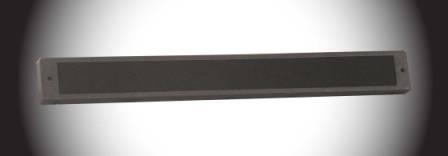Dakota Audio » Products » MA-4
Products
0.9 inches (22mm) deep x 2 inches (50mm) tall
Stocked in the following lengths:
18 inches - 457mm
22 inches - 558mm
23 inches - 584mm
25 inches - 635mm
30 inches - 762mm
36 inches - 914mm
38 inches - 965mm
MA-4 Mini Array
The Dakota Audio MA-4 was designed with two criteria in mind, small size and excellent intelligibilty in a noisy environment. The original intent was excellent intelligibility in applications such as science museums where the background noise level can be quite high. (See product brochure).
Interested in a Fuller Range Mini Array? See our All New MA-5!
The Dakota Audio MA-4 is ideal for Flat Panel Displays (LCD or Plasma) or with Digital Signage Solutions.
MA-4's may also be ordered in custom lengths to fit the application (there is a setup charge for custom lengths). Providing good sound control in a small package, the Mini-Array provides one-dimensional sound control. The pattern control is good side-to-side, while the vertical pattern is very wide.
This gives good sonic isolation between displays while providing good coverage of the listeners regardless of their height.
To further reduce the visible element of the MA-4, the amplifier (0.9 inches / 22 mm x 5 inches / 127 mm x 3.25 inches / 82mm) is remote from the speaker array, connected by a multi-conductor cable (supplied). There are two line level inputs. One is a transformer isolated balanced input, the other is a 3.5mm mini-jack that accepts stereo inputs and combines them to mono.
The volume control is active for the 3.5mm jack. The gain for the balanced input is fixed. The arrays are powered by a supplied plug-in 12VDC power supply.
The units are constructed of 18 gauge steel with a reinforced fabric grill. The finish is black non-reflective powder coating. Other finishes and colors are available by special order. MA-4's have a single mounting hole at each end.
In typical applications, the Mini-arrays are mounted horizontally directly above or below a video or touch screen. For very large screens mouned in portrait mode, we recommend two speaker arrays, one at the top, the other at the bottom of the display. The amplifier has two outputs and will drive two speaker arrays.
Other applications include kiosks, museums, digital signage, P.O.P. displays, trade shows, or any other application that requires one-dimensional sound control in a small package.


